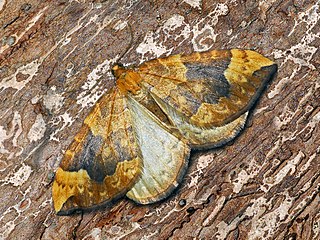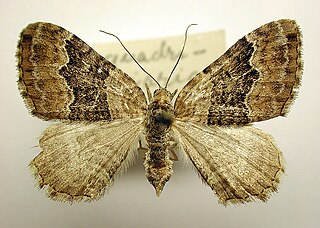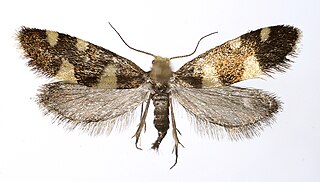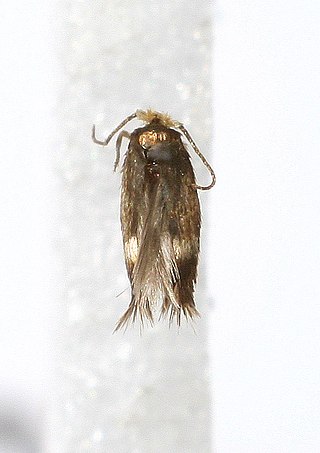
Notodontidae is a family of moths with approximately 3,800 known species. The family was described by James Francis Stephens in 1829. Moths of this family are found in all parts of the world, but they are most concentrated in tropical areas, especially in the New World.

The buff-tip is a moth of the family Notodontidae. It is found throughout Europe and in Asia to eastern Siberia. The species was first described by Carl Linnaeus in his 1758 10th edition of Systema Naturae.

Eulithis populata, the northern spinach, is a moth of the genus Eulithis in the family Geometridae.

Pandemis cerasana, the barred fruit-tree tortrix, is a moth of the family Tortricidae.

Spoladea recurvalis, the beet webworm moth or Hawaiian beet webworm moth, is a species of moth of the family Crambidae. It is found worldwide, but mainly in the tropics.

Alucita hexadactyla is a "micromoth" of the many-plumed moth family (Alucitidae). It is found in Eurasia. It was previously thought to also occur in North America, but a 2004 study showed that the North American species are distinct and separate.

Synanthedon tipuliformis, known as the currant clearwing, is a moth of the family Sesiidae. It is endemic to the Palearctic realm, but is an invasive species in the Nearctic realm and the Australasian realm.

Zophodia grossulariella is a species of moth of the family Pyralidae. It is found in Europe and North America.

Eriocrania salopiella is a moth of the family Eriocraniidae and is found in Europe. It was described by the English entomologist, Henry Tibbats Stainton in 1854. The larvae mine the leaves of birch.

Xanthorhoe quadrifasiata, the large twin-spot carpet, is a moth of the family Geometridae. It is found in most of Europe, east to the Near East and the eastern part of the Palearctic realm.

Alloclemensia mesospilella is a moth of the family Incurvariidae. It is found from Fennoscandia and northern Russia to the Pyrenees, Italy, and Romania.

Stigmella microtheriella is a moth of the family Nepticulidae, found in Asia, Europe and New Zealand. The larvae mine the leaves of hazel and hornbeams. It was described by the English entomologist, Henry Tibbats Stainton in 1854 from a type specimen found in England.

Lampronia standfussiella is a moth of the family Prodoxidae. It is found in central Europe, including the Alps, Germany, Austria and Poland, north to Finland and Sweden and northern Russia.

Eudemis porphyrana is a moth of the family Tortricidae. It is found in most of Europe, east to the eastern part of the Palearctic realm.

Stigmella lapponica is a moth of the family Nepticulidae found in Asia, Europe and North America. It was first described by the German entomologist, Maximilian Ferdinand Wocke in 1862. The larvae mine the leaves of birch.

Eulithis pyropata is a moth of the family Geometridae. It is found from extreme north-eastern Europe to Japan and the area surrounding the Ussuri River.

The currant shoot borer moth is a species of moth of the family Prodoxidae. It is found in most of central, northern and eastern Europe. It is also found in North America.

Agonopterix carduella is a moth of the family Depressariidae. It is found from Great Britain, Germany and Estonia to the Iberian Peninsula, Sardinia, Italy and Montenegro.

Callidrepana patrana is a moth in the family Drepanidae. It was described by Frederic Moore in 1866. It is found in Nepal, India, Cambodia, Sri Lanka, Thailand, mainland China, Japan and Taiwan.
Euhyponomeutoides albithoracellus, the currant bud moth, is a moth of the family Yponomeutidae. It is found in Fennoscandia, Denmark, Germany, Poland, the Baltic region, Romania, Slovakia, Austria, Switzerland and France.

















